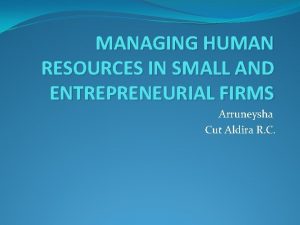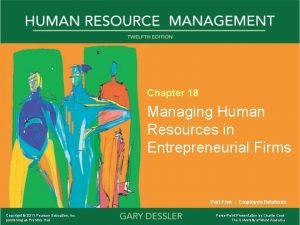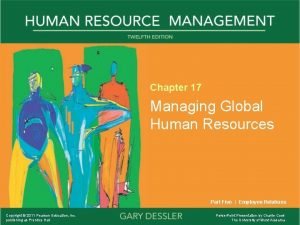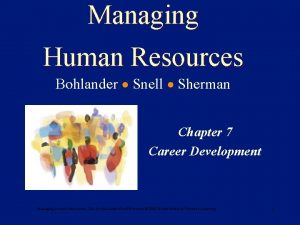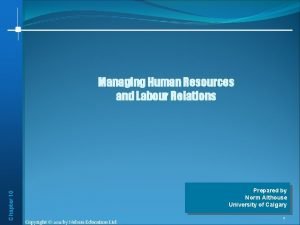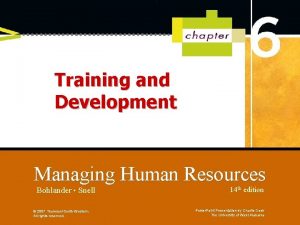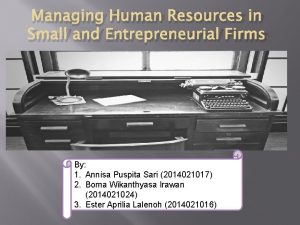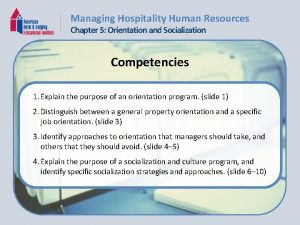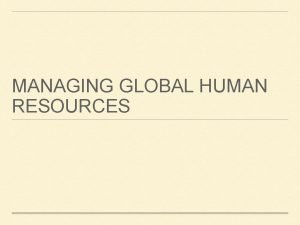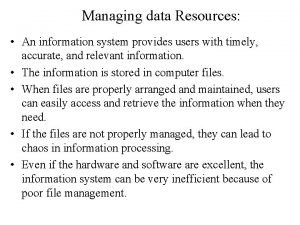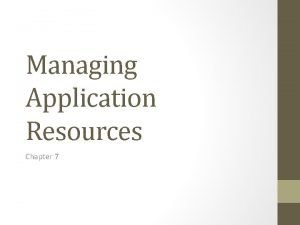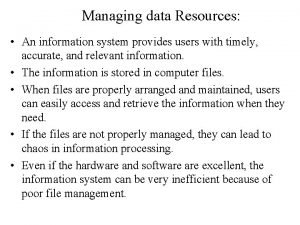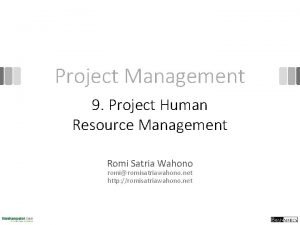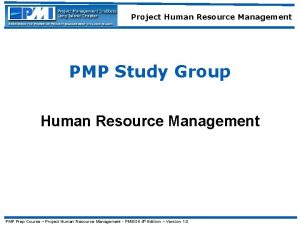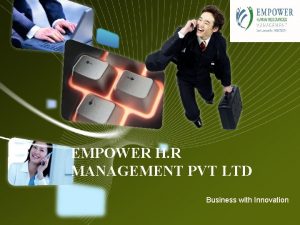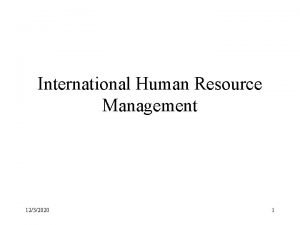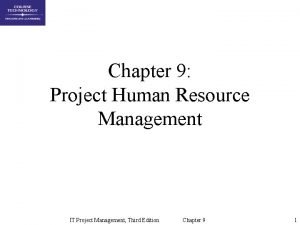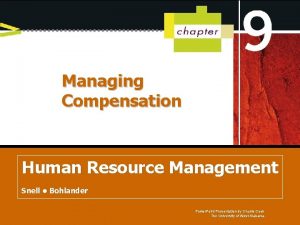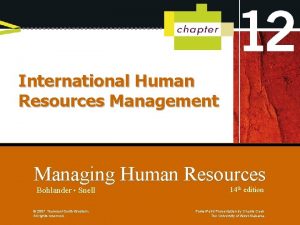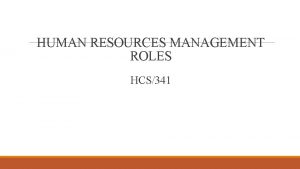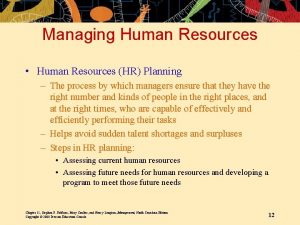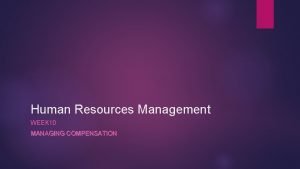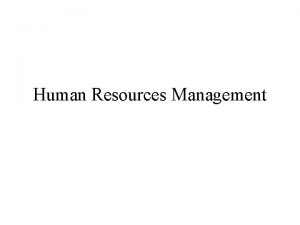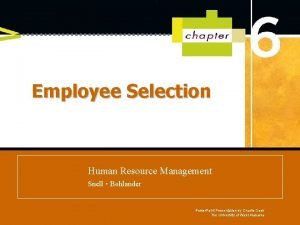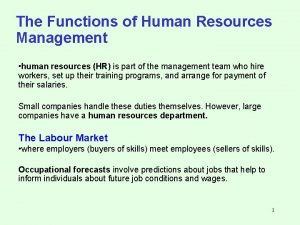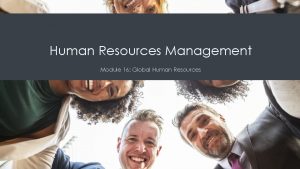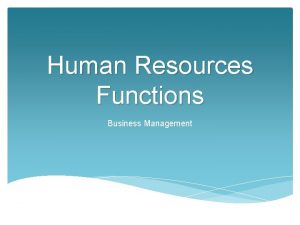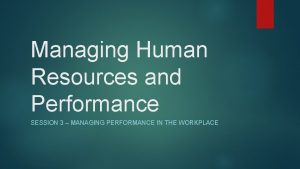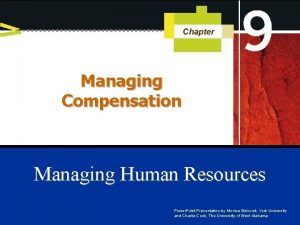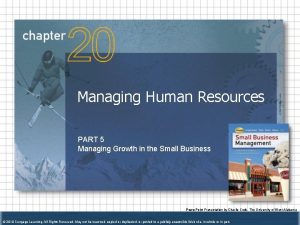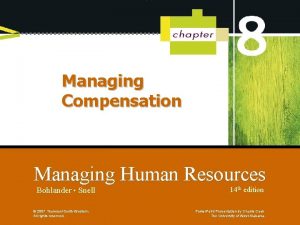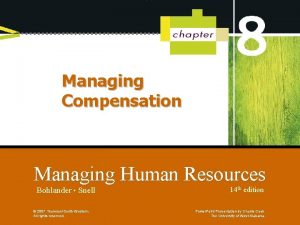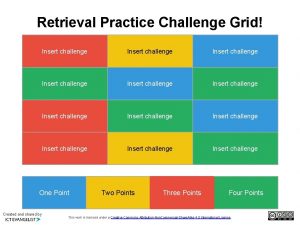The Challenge of Human Resources Management Managing Human


























- Slides: 26

The Challenge of Human Resources Management Managing Human Resources Bohlander • Snell Copyright © 2007 Thomson/South-Western. All rights reserved. 14 th edition Power. Point Presentation by Charlie Cook The University of West Alabama

Why Study Human Resources Management • Human Resources Management (HRM) Ø The process of managing human resources (human capital and intellectual assets) to achieve an organization’s objectives. • “Why Study HRM? ” Ø Staffing the organization, designing jobs and teams, developing skillful employees, identifying approaches for improving their performance, and rewarding employee successes—all typically labeled HRM issues—are as relevant to line managers as they are to managers in the HR department. Copyright © 2007 Thomson South. Western. All rights reserved. 1– 2

Competitive Advantage through People • Core Competencies Ø Integrated knowledge sets within an organization that distinguish it from its competitors and deliver value to customers. • Sustained competitive advantage through people is achieved if these human resources: Ø Have value. Ø Are rare and unavailable to competitors. Ø Are difficult to imitate. Ø Are organized for synergy. Copyright © 2007 Thomson South. Western. All rights reserved. 1– 3

Figure 1– 1 Overall Framework for Human Resource Management Copyright © 2007 Thomson South. Western. All rights reserved. 1– 4

Competitive Challenges and Human Resources Management • The most pressing competitive issues facing firms: 1. Going global 2. Embracing new technology 3. Managing change 4. Managing talent, or human capital 5. Responding to the market 6. Containing costs Copyright © 2007 Thomson South. Western. All rights reserved. 1– 5

Challenge 1: Going Global • Globalization Ø The trend toward opening up foreign markets to international trade and investment • Impact of globalization Ø “Anything, anywhere, anytime” markets Ø Partnerships with foreign firms Ø Lower trade and tariff barriers Copyright © 2007 Thomson South. Western. All rights reserved. 1– 6

Challenge 1: Going Global (cont’d) • Impact on HRM Ø Different geographies, cultures, laws, and business practices Ø Issues: Identifying capable managers and workers v Developing foreign culture and work practice training programs. v Adjusting compensation plans for overseas work v Copyright © 2007 Thomson South. Western. All rights reserved. 1– 7

Challenge 2: Embracing New Technology • Knowledge Workers Ø Workers whose responsibilities extend beyond the physical execution of work to include planning, decision making, and problem solving. • Knowledge-Based Training Online instruction v “Just-in-time” learning via the Internet on company intranets v Copyright © 2007 Thomson South. Western. All rights reserved. 1– 8

Influence of Technology in HRM • Human Resources Information System (HRIS) Ø A computerized system that provides current and accurate data for the purposes of control and decision making. Ø Benefits: v Store and retrieve of large quantities of data. v Combine and reconfigure data to create new information. v Institutionalization of organizational knowledge. v Easier communications. v Lower administrative costs, increased productivity and response times. Copyright © 2007 Thomson South. Western. All rights reserved. 1– 9

Highlights in HRM 2 Most Common HR Information Systems Applications Payroll 76. 7% Benefits administration 57. 1 Benefits enrollment 41. 4 Recruiting—applicant tracking 39. 1 Personnel administration 39. 1 Training and development 31. 6 Employee self-service 24. 8 Manager self-service 18. 0 Other Copyright © 2007 Thomson South. Western. All rights reserved. Source: “How HR Managers Use Technology Applications to Control HR Department Costs, ” Human Resource Department Management Report, no. 4– 5 (May 2004). 3. 8 1– 10

Challenge 3: Managing Change • Types of Change Ø Reactive change v Change that occurs after external forces have already affected performance Ø Proactive change v Change initiated to take advantage of targeted opportunities • Managing Change through HR Ø Formal change management programs help to keep employees focused on the success of the business. Copyright © 2007 Thomson South. Western. All rights reserved. 1– 11

Challenge 3: Managing Change (cont’d) • Why Change Efforts Fail: 1. 2. 3. 4. 5. 6. Not establishing a sense of urgency. Not creating a powerful coalition to guide the effort. Lacking leaders who have a vision. Lacking leaders who communicate the vision. Not removing obstacles to the new vision. Not systematically planning for and creating shortterm “wins. ” 7. Declaring victory too soon. 8. Not anchoring changes in the corporate culture. Copyright © 2007 Thomson South. Western. All rights reserved. 1– 12

DISCUSSION Qs • 1. Are people always an organization’s most valuable asset? Why or why not? • 2. Will technology eliminate the need for human resources managers? • 3. What are the pros and cons of change? Does it help or hurt organizational performance? Do you like change? Why or why not?

Challenge 4: Managing Talent, or Human Capital • Human Capital Ø The knowledge, skills, and capabilities of individuals that have economic value to an organization. Ø Valuable because capital: is based on company-specific skills. v is gained through long-term experience. v can be expanded through development. v Copyright © 2007 Thomson South. Western. All rights reserved. 1– 14

Challenge 5: Responding to the Market • Total Quality Management (TQM) Ø A set of principles and practices whose core ideas include understanding customer needs, doing things right the first time, and striving for continuous improvement. Copyright © 2007 Thomson South. Western. All rights reserved. 1– 15

Challenge 5: Responding to the Market (cont’d) • Reengineering and HRM Ø Fundamental rethinking and radical redesign of business processes to achieve dramatic improvements in cost, quality, service, and speed. v Requires that managers create an environment for change. v Depends on effective leadership and communication processes. v Requires that administrative systems be reviewed and modified. Copyright © 2007 Thomson South. Western. All rights reserved. 1– 16

Challenge 6: Containing Costs • Downsizing Ø The planned elimination of jobs (“head count”). Ø Layoffs • Outsourcing Ø Contracting outside the organization to have work done that formerly was done by internal employees. • Offshoring Ø The business practice of sending jobs to other countries. Copyright © 2007 Thomson South. Western. All rights reserved. 1– 17

Challenge 6: Containing Costs (cont’d) • Employee Leasing Ø The process of dismissing employees who are then hired by a leasing company (which handles all HRrelated activities) and contracting with that company to lease back the employees. Copyright © 2007 Thomson South. Western. All rights reserved. 1– 18

Challenge 6: Containing Costs (cont’d) • Hidden Costs of Layoff Ø Severance and rehiring costs Ø Accrued vacation and sick day payouts Ø Pension and benefit payoffs Ø Potential lawsuits from aggrieved workers Ø Loss of institutional memory and trust in management Ø Lack of staffers when the economy rebounds Ø Survivors who are risk-averse, paranoid, and political Copyright © 2007 Thomson South. Western. All rights reserved. 1– 19

Challenge 6: Containing Costs (cont’d) • Benefits of a No-Layoff Policy Ø A fiercely loyal, more productive workforce Ø Higher customer satisfaction Ø Readiness to snap back with the economy Ø A recruiting edge Ø Workers who aren’t afraid to innovate, knowing their jobs are safe. Copyright © 2007 Thomson South. Western. All rights reserved. 1– 20

Figure 1– 4 Productivity Enhancements Copyright © 2007 Thomson South. Western. All rights reserved. 1– 21

Managing Diversity àBeing acutely aware of characteristics common to employees, while also managing these employees as individuals. àIt means not just tolerating or accommodating all sorts of differences but supporting, nurturing, and utilizing these differences to the organization’s advantage. Copyright © 2007 Thomson South. Western. All rights reserved. 1– 22

Highlights in HRM 5 Source: Survey data from© Gail 2007 Robinson and Kathleen Dechant, “Building a Business Case for Diversity, ” Academy of Copyright Thomson South. Management Executive 11, no. 3 (August 1997): 21– 31; permission conveyed through the Copyright Clearance Center, Inc. Western. All rights reserved. 1– 23

Qualities of Human Resources Managers • Responsibilities • Competencies 1. Advice and counsel 1. Business mastery 2. Service 3. Change mastery 3. Policy formulation and implementation 4. Personal credibility 2. HR mastery 4. Employee advocacy Copyright © 2007 Thomson South. Western. All rights reserved. 1– 24

Figure 1– 9 Human Resource Competency Model Source: Arthur Yeung, Wayne Brockbank, and Dave Ulrich, “Lower Cost, Higher Value: Human Resource Function in Transformation. ” Reprinted Copyright © 2007 Southwith permission from Human Resource. Thomson Planning, Vol. 17, No. 3 (1994). Copyright 1994 by The Human Resource Planning Society, 317 Madison Avenue, Suite 1509, New York, NY 10017, Phone: (212) 490 -6387, Fax: (212) 682 -6851. Western. All rights reserved. 1– 25

DISCUSSION Qs • 1. What are the pros and cons of having a more diverse workforce? • 2. In your opinion, what is the most important role of HR managers? Copyright © 2007 Thomson South. Western. All rights reserved. 1– 26
 Managing human resources in small and entrepreneurial firms
Managing human resources in small and entrepreneurial firms Employee selection
Employee selection Managing global human resources
Managing global human resources Managing human resources snell
Managing human resources snell Chapter 10 managing human resources
Chapter 10 managing human resources Bohlander and snell
Bohlander and snell Managing human resources in small and entrepreneurial firms
Managing human resources in small and entrepreneurial firms Managing hospitality human resources
Managing hospitality human resources Managing global human resources
Managing global human resources Whitchester house
Whitchester house Managing data resources
Managing data resources Lpdi
Lpdi Importants of hrm
Importants of hrm Data resources in information system
Data resources in information system Information technology resource
Information technology resource Human resource histogram
Human resource histogram Project management human resources
Project management human resources Human resource and job design in operations management
Human resource and job design in operations management Empower human resources
Empower human resources Defination of hrm
Defination of hrm Chapter 9 human resources management
Chapter 9 human resources management Human resource management final exam
Human resource management final exam Retail org chart
Retail org chart Human resource management lecture chapter 1
Human resource management lecture chapter 1 Human resource management weiterbildung
Human resource management weiterbildung Human resource management gaining a competitive advantage
Human resource management gaining a competitive advantage Chapter 9 human resources management
Chapter 9 human resources management
